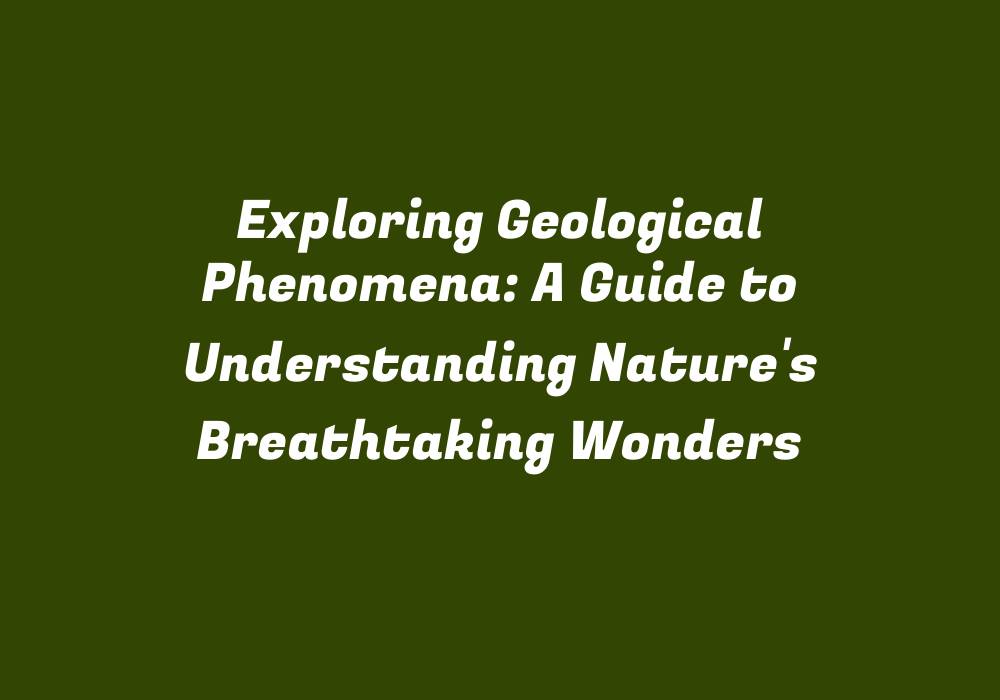Exploring Geological Phenomena: A Guide to Understanding Nature’s Breathtaking Wonders
Geology, the study of Earth’s materials and processes, is a fascinating subject that has given us an insight into the planet we inhabit. The incredible forces that shape our world have led to various geological phenomena. These wonders of nature are not only captivating but also help us understand the dynamic Earth we live in. From towering mountain ranges to magnificent volcanoes, this article will delve into some of these amazing geological phenomena and their significance.
Volcanic Eruptions
One of the most dramatic natural occurrences is the eruption of a volcano. These earth-shattering events involve the release of molten rock, ash, lava, and gases from beneath the Earth’s crust, often due to tectonic plate movements. Volcanic eruptions have shaped our planet over millions of years, forming some of its most breathtaking landscapes.
There are three primary types of volcanoes: composite (or stratovolcano), shield, and cinder cone. Composite volcanoes, known for their steep sides, often resemble the shape of a mountain or cone due to the alternating layers of lava and ash deposits that build up over time. Shield volcanoes are flat-topped structures formed by fluid lava flows, creating low and broad profiles that resemble ancient warrior shields. Cinder cones are small conical mountains formed from ejected fragments of pumice, lava fragments, or blocks of cooled magma.
Volcanic eruptions can result in the formation of diverse geological features like craters, caves, and lava tubes. These volcanoes also play a significant role in shaping our climate as they release greenhouse gases into the atmosphere. Understanding their impact on ecosystems and the environment is essential for us to make informed decisions in mitigating the effects of these eruptions.
Mountain Ranges
The towering mountain ranges that dot our planet are a testament to the power of Earth’s forces. Geologists have identified several mechanisms responsible for the formation of mountains, including orogeny, volcanic activity, and tectonic plate movements. Orogeny involves the folding and crumpling of the Earth’s crust due to plate collision and the accumulation of sediments, while volcanic eruptions can build up into mountain chains. Tectonic plate movements are also responsible for creating faults and folds in the Earth’s crust, which may eventually form mountains over time.
Mountain ranges provide some of the world’s most breathtaking views. From the majestic Himalayas to the towering Andes, these landforms have inspired artists, writers, and explorers throughout history. They are also essential for life on Earth as they act as water towers, storing vast quantities of freshwater in their snowcaps and glaciers which are released gradually, providing essential resources to downstream regions.
Earthquakes
Earthquakes occur when the Earth’s crust suddenly releases built-up stress resulting from tectonic plate movements. This sudden release of energy travels through the planet as seismic waves, causing shaking and sometimes destruction on the Earth’s surface. While they can be devastating to human life and infrastructure, earthquakes are essential in shaping our planet. They contribute to the formation of mountains and valleys, influence the movement of rivers, and play a role in the recycling of materials within the Earth’s crust.
The Richter Scale is used to measure the magnitude of an earthquake based on the amplitude of seismic waves. The more energy released during an earthquake, the higher the Richter value. While large-scale earthquakes can be unpredictable, understanding their mechanisms and patterns helps us in anticipating potential risks and taking appropriate measures to minimize damage.
Faults and Folds
Faults are discontinuities in Earth’s crust caused by the movement of tectonic plates or other geological processes. They can be categorized as normal faults (where rocks slide downward), reverse faults (rocks slide upwards), and strike-slip faults (rocks move horizontally). Faults are often associated with earthquakes, landslides, and the formation of mountains. On the other hand, folds are curved structures formed when strata are bent, compressed, or buckled by tectonic forces or erosion.
Both faults and folds play a critical role in shaping our planet’s landscape and influencing its evolution. They provide vital clues for geologists to understand past Earth movements and make predictions about future events. By analyzing these features, scientists can develop better models of the Earth’s tectonic history and anticipate potential hazards associated with seismic activity.
Caves
Caves are subterranean spaces formed naturally in rock masses through various geological processes. They may be created by water erosion, the dissolution of rocky formations, or the collapse of cave roofs. The study of caves and their formation offers valuable insight into our planet’s history and geological processes. Cave systems are also home to numerous unique animal species that have adapted to life in complete darkness.
Caves can be found across various geological formations, including limestone and karst landscapes, where they often serve as water reservoirs, supporting critical ecosystems and human activities like agriculture. Their presence is also a vital indicator of underlying geologic structures and processes, which can inform the study of tectonic plates or past climatic changes.
Conclusion
Geological phenomena are indeed breathtaking wonders that continue to fascinate us. From towering mountain ranges to mysterious caves, these natural forces have shaped our planet’s landscapes and influenced its history. A comprehensive understanding of geology is crucial not only for appreciating the beauty and complexity of Earth but also for making informed decisions about how we interact with it. By continuing to explore and investigate these wonders of nature, we can gain new insights into our world while fostering a deeper appreciation for our planet’s extraordinary geologic diversity.
By delving deep into the fascinating world of geology, we not only broaden our understanding of Earth’s history but also develop an appreciation for its breathtaking wonders. From mountain ranges to volcanic eruptions, caves, and faults, each phenomenon offers a unique glimpse into how our planet has evolved over time.
